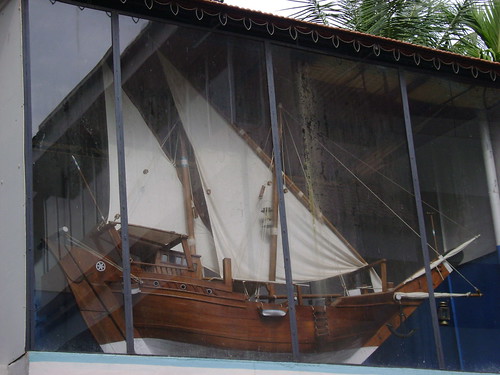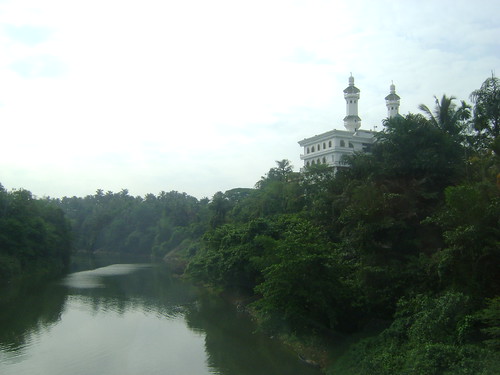By Kashif-ul-Huda, TwoCircles.net
TCN Malabar series: Part 9
Historically, Muslims of Malappuram were mostly agricultural laborers while Mulims living in coastal areas of Kannur, Kozhikode, and Ponnani were involved in trade and shipping. Lagging behind in education in the first half of the twentieth century limited the Mappilas’ access to the new economic opportunities in Independent India. The demand for labor in the Gulf countries opened only a small window of economic opportunity, however, the Mappilas were able to take full advantage of this. Using their strong determination and hard work, they put Kerala Muslims on the path to progress, giving shape to a community that the rest of the Indian Muslims can learn from.

A model of the famous Malabari ship
Without education and lacking skills, Mappilas had nowhere to go except illegally migrate to the Gulf countries where there was an increased demand for labor due to the oil boom. Taking great risks, the early pioneers worked as unskilled laborers and slowly established themselves to start businesses. The migration that started in the 1970s continues to this day and has made the Mappilas one of the most dynamic Muslim communities of India.
Keralites in general have migrated abroad since the 1930s but Muslims were the last ones to join the migratory workforce. While Christians went abroad to be employed as professionals, Hindu lower castes migrated earlier to Singapore and Malaysia and then to the Gulf as technicians. It was not till the 1970s that Muslims started migrating to the Gulf countries aboard ships coming to Kerala for spices and other items bound to the Persian Gulf. Even though they were putting their lives in danger, the Mappilas worked hard and found a way out of their economic backwardness.
According to one estimate, about 90% of emigrants from Kerala are in Gulf countries. Muslims form the single largest group of the Keralite workforce abroad. 42% of Malyalalees in the Gulf countries are Muslims; Hindus make-up 37% and Christians 21.2%.
Estimates on how much money comes into Kerala though remittances vary, but it contributes significantly to Kerala’s economy. The effect of Dubai’s recent economic problem is clearly visible in Kerala where partially constructed homes are mute testimony of shattered dreams. Kerala has seen better days and though all communities benefitted from the economic boom in West Asia, Mappilas as a community were the largest beneficiary.
While Ezhavas and Syrian Christians who went to work abroad became prosperous themselves and even helped their religious places of worship a bit but none invested as heavily in their community as the Mappilas did. Muslims contributed significantly in building new mosques, establishing schools, and helping other Muslims find employment or set up businesses. This ensured that all Muslims shared in the prosperity. As a result, they have moved up in the social scale as a community – a wonderful example of Islamic brotherhood.

Minarets rising from the jungle in Malappuram.
New wealth has also meant that more elaborate and new masjids with architecture heavily influenced by latest Arab trends are taking the place of traditional mosques. Other religious institutions have also benefitted from charitable donations and some of the money has translated into better schools. We also see some new innovation in madrasa education, Darul Huda being one such example.
Money has also given new confidence to the community and they do not hesitate to help community institutions and groups. The strength of these groups has given them political leverage at the state and national level.

A construction halted, a dream on pause
This new found economic growth has a dark side as well. Easy access to community network that makes it attractive for young men to try their luck in the Gulf countries also means that most of them see no point in acquiring higher education. Most young men seek a way out after secondary education; not withstanding impressive educational achievement over the years, Muslim representation has fallen drastically for higher education in Kerala. It is no accident that Muslim girls dominate in professional courses of Farook College.
As men migrate to earn money, in most cases the children they leave behind grow up in a single parent family headed by a female. Mappilas being a conservative society help control what could have turned into major social problems, but for how long?
Success overseas has led Muslims to establish themselves economically in their homeland as well. If their business acumen, hard work, and social network are offered the opportunity of business school training and innovation that comes with higher education, Mappilas will be soon be ready to move into the big leagues of the Indian business scene.
Ref:
Kurien, Prema, A Socio-Cultural Perspective on Migration and Economic Development: Middle Eastern Migration from Kerala, India (Geneva: International Organization for Migration, 2008).
